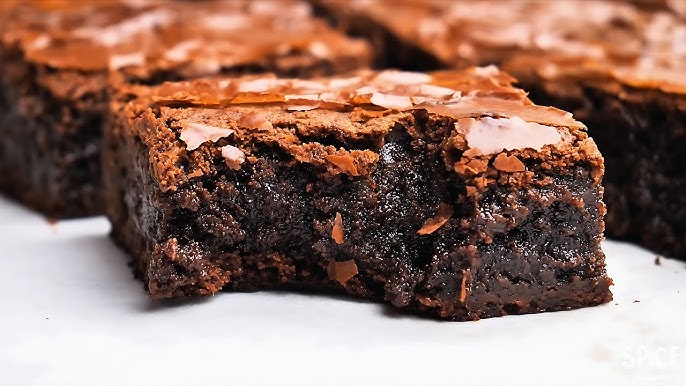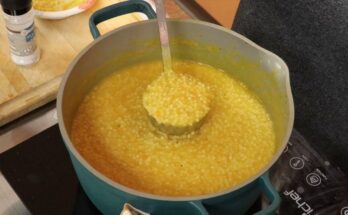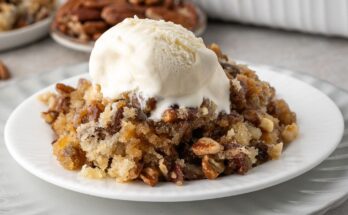Brownies Recipe: Brownies are the ultimate comfort dessert. With their gooey texture, rich chocolate flavor, and versatility, brownies are a favorite for all ages. Whether you’re a fan of fudgy, chewy, or cakey varieties, there’s no denying their universal appeal.
The History of Brownies
Originating in the United States in the late 19th century, brownies were an accidental creation by a baker who forgot to add baking powder. Over time, they’ve become a dessert staple, celebrated for their simplicity and decadence.
Different Types of Brownies
From classic chocolate brownies to innovative versions like salted caramel or vegan brownies, there’s a type for every taste bud. Let’s dive into making a classic, fudgy brownie with tips to customize it to your liking.
Ingredients for the Perfect Brownie
The foundation of a great brownie lies in its ingredients:
- Cocoa Powder and Chocolate: High-quality unsweetened cocoa powder and semi-sweet chocolate give brownies their rich flavor.
- Butter: Adds moisture and a creamy texture.
- Sugar: Balances the bitterness of cocoa and chocolate. Granulated sugar creates a chewy texture, while brown sugar adds a hint of caramel.
- Eggs: Help bind the ingredients and contribute to the texture.
- Flour: Use all-purpose flour for a balanced structure—too much can make brownies cakey.
Optional Add-Ins for Creative Brownies
Customize your brownies with add-ins like:
- Chopped nuts for crunch.
- Chocolate chips for pockets of melted chocolate.
- Marshmallows or peanut butter swirls for a gourmet twist.
Essential Tools You’ll Need
Baking Equipment List
Ensure you have these tools ready before starting:
- Mixing bowls
- Whisk or electric mixer
- Rubber spatula
- Measuring cups and spoons
- 8×8 or 9×9-inch baking pan
Why the Right Pan Matters?
The pan size and material significantly affect your brownies. A metal pan ensures even heat distribution, while a glass pan may require slightly longer baking. Stick to the recommended pan size to maintain the right thickness.
Preparing for Success
Preheating the Oven
Set your oven to 350°F (175°C) before you begin mixing ingredients. Proper preheating ensures your brownies bake evenly.
Properly Measuring Ingredients
Accuracy is key when baking. Scoop and level flour to avoid packing too much, which can make the brownies dense. Use a kitchen scale for the most accurate results.
Preparing the Pan for Baking
Line your baking pan with parchment paper, leaving an overhang on two sides for easy removal. Alternatively, grease the pan with butter or non-stick spray.
Step-by-Step Brownie Recipe
Mixing Dry Ingredients
In a medium bowl, whisk together flour, cocoa powder, and a pinch of salt. This ensures even distribution and prevents clumps.
Melting Chocolate and Butter
In a heatproof bowl, melt butter and semi-sweet chocolate together using a microwave or double boiler. Stir until smooth and glossy, then let it cool slightly.
Combining Wet and Dry Mixtures
In a large bowl, beat eggs and sugar until fluffy. Slowly mix in the melted chocolate mixture. Gradually add the dry ingredients, stirring just until combined—don’t overmix, as this can affect the texture.
Pouring the Batter into the Pan
Pour the batter into the prepared pan, spreading it evenly with a spatula. Tap the pan on the counter to release any air bubbles.
Baking and Cooling Process
Bake for 25-30 minutes or until a toothpick inserted in the center comes out with moist crumbs. Cool the brownies completely in the pan before slicing.
Pro Tips for Perfect Brownies
Achieving the Desired Texture
Brownies are all about texture, and getting it right depends on a few factors:
- For fudgy brownies, use less flour and add an extra egg yolk. The higher fat content creates a denser texture.
- For chewy brownies, mix granulated sugar with a bit of brown sugar. The moisture in brown sugar contributes to chewiness.
- For cakey brownies, add a little more flour and whisk the batter longer to incorporate more air.
Avoiding Common Mistakes
- Don’t overbake. Brownies continue to cook as they cool, so take them out when the edges are set, and the center is slightly underdone.
- Avoid overmixing the batter. This can lead to tough, dense brownies.
- Use room temperature ingredients to ensure everything blends smoothly.
Creative Brownie Variations
Double Chocolate Brownies
For an extra indulgent treat, fold in a generous handful of chocolate chips or chunks before pouring the batter into the pan. These melt as the brownies bake, creating pools of molten chocolate.
Salted Caramel Brownies
Swirl in a few spoonfuls of salted caramel sauce into the batter before baking. Sprinkle flaky sea salt on top for a sweet-and-savory contrast.
Vegan and Gluten-Free Options
Replace eggs with flaxseed meal mixed with water (1 tablespoon flaxseed + 2.5 tablespoons water = 1 egg). Use almond or oat flour in place of regular flour. Ensure your chocolate and butter substitutes are vegan-friendly.
Serving and Storing Brownies
How to Cut Brownies Perfectly
For clean, sharp edges, wait until the brownies are completely cool. Use a sharp knife dipped in hot water and wiped dry between cuts.
Best Ways to Store for Freshness
- Store brownies in an airtight container at room temperature for up to 3 days.
- To keep them longer, refrigerate for up to a week or freeze for up to 3 months. Wrap each brownie individually in plastic wrap, then place them in a freezer-safe bag.
FAQs About Brownies Recipe
Q1: What ingredients are needed to make brownies?
The key ingredients for brownies include flour, sugar, cocoa powder, eggs, butter, and chocolate. You can also add optional items like nuts, vanilla extract, or chocolate chips for extra flavor.
Q2: How do I achieve fudgy brownies?
To make fudgy brownies, use more butter and chocolate compared to flour. Avoid overmixing the batter, and bake at the recommended temperature to keep the texture moist.
Q3: Can I make brownies without eggs?
Yes, you can substitute eggs with ingredients like applesauce, mashed bananas, yogurt, or a flaxseed mixture to create egg-free brownies.
Q4: How do I prevent brownies from sticking to the pan?
Line your baking pan with parchment paper or grease it with butter or non-stick spray to ensure easy removal after baking.
Q5: How do I store leftover brownies?
Store brownies in an airtight container at room temperature for up to 3 days. For longer storage, refrigerate them or freeze individually wrapped pieces for up to 3 months.
Q6: Can I use alternative sweeteners for brownies?
Yes, you can use alternatives like honey, maple syrup, or artificial sweeteners. Keep in mind that these may slightly alter the texture and taste of the brownies.
Q7: What is the best way to reheat brownies?
Reheat brownies in the microwave for 10-15 seconds or in the oven at a low temperature for a few minutes to maintain their softness and flavor.
Conclusion
Homemade brownies win every time—they’re fresher, customizable, and made with love. Plus, you control the quality of ingredients, ensuring a more satisfying and wholesome treat.
The best part of baking is sharing! Experiment with flavors, textures, and toppings to create your signature brownie recipe. Share them with friends and family—they’ll thank you for it!



